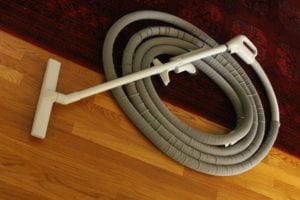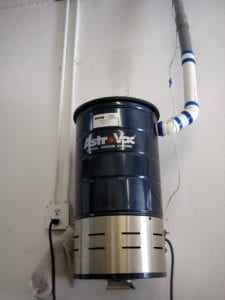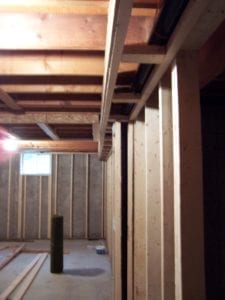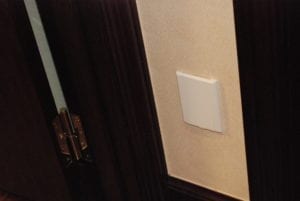While installing a central vacuum system is possible in an existing home, many homeowners take the easy route and plan for this type of vacuum system when building a new custom home. By adding this amenity during the construction process you avoid the costly renovation issues that come with modifying pre-existing homes.
Follow these tips for installing a central vacuum system during the home building process and save yourself money, time, and maintenance issues down the road.
What Is a Central Vacuum System?
A central vacuum system is a permanent fixture that uses inlets installed in the walls of the home.
This system makes cleaning much easier because it works without releasing dirt particles into the air and provides three to five times more suction power than a traditional vacuum.
All central vacuum systems are made up of three basic parts: a power unit, a tubing system, and a collection vessel.
Avoid getting a central vacuum system that uses filtration bags, as these can cost a significant amount of money over time. The filtration bags can break, leading to motor damage due to dirt clogs and additional repairs. Central vacuums that use collection buckets instead of filtration bags will simply lose suction power when they are nearly full, signaling that it is time to empty them. These buckets release from the system easily, allowing you to quickly dispose of accumulated dirt.
Installing Central Vacuum Power Units
The power unit of the central vacuum system should be installed in a dry, cool room of the house with the least amount of foot traffic. Some good locations for the power unit include the basement or garage.
The disposal canister connects to the power unit in most systems, so make sure that there is an exterior wall nearby to run the exhaust line. Power units for central vacuums generally last longer if kept in a well-ventilated area that does not reach high temperatures.
Tubing: Considering Potential Central Vacuum Repair
Running the tubing during a new home build allows your construction team to put down the tubing before the floors are installed. If there is limited space beneath your flooring, the tubing can be installed within the walls or even in an attic space. Always try to run the pipes the shortest distance possible. The picture at right shows a soffit built across the upper righthand side of the room to contain pipes and central vac tubing.
With any central vacuum system, the more tubing or inlets you install, the greater the chance for drops in pressure due to leaks. Extra tubing also costs you more money. Use as little tubing as possible for the most efficient and affordable central vacuum system.
In a one-story home, consider running the tubing through the crawlspace beneath the house. By doing this, maintenance workers can easily get access to the vacuum tubing in case repairs need to be made in the future.
Choosing the Right Amount of Inlets
Strategically plan where the inlets need to go to improve the durability, and lower the cost, of the entire system. A good rule of thumb is to measure about thirty feet (the length of the average hose) from every intended inlet installation location. If you can’t reach every corner and crevice you plan on vacuuming from that spot, you need more inlets.
On average, most people install one to three inlets per floor, depending on square footage. If you are unsure, talk to your home building team to decide how many inlets will work best in your home and get suggestions for the best locations.
The Best Central Vacuum Attachments
If you decide to get a central vacuum system and want all the extras for your home, think about purchasing these optional attachments.
1. Hide a Hose:
Instead of lugging bulky hoses throughout the house when cleaning, consider installing the hide-a-hose system. This additional attachment retracts inside your wall, allowing you to easily pull out the hose to vacuum whenever necessary but keep it conveniently stored when done cleaning.
2. Wall Vacuum Sweep Inlets:
These additional inlets let you sweep directly into the system instead of hooking up the hose. These work well in rooms that get a lot of foot traffic, such as the kitchen or entrance hallway.
Central vacuum systems keep your home cleaner and eliminate the effort of hauling a hand-held vacuum throughout the house. These systems can be installed in a matter of days and simplify your cleaning routine for a lifetime.
If you are thinking about building a new custom home, or are hiring an outside company to assist you in a homebuilding project, talk to your contractor about adding a central vacuum to your plans.




